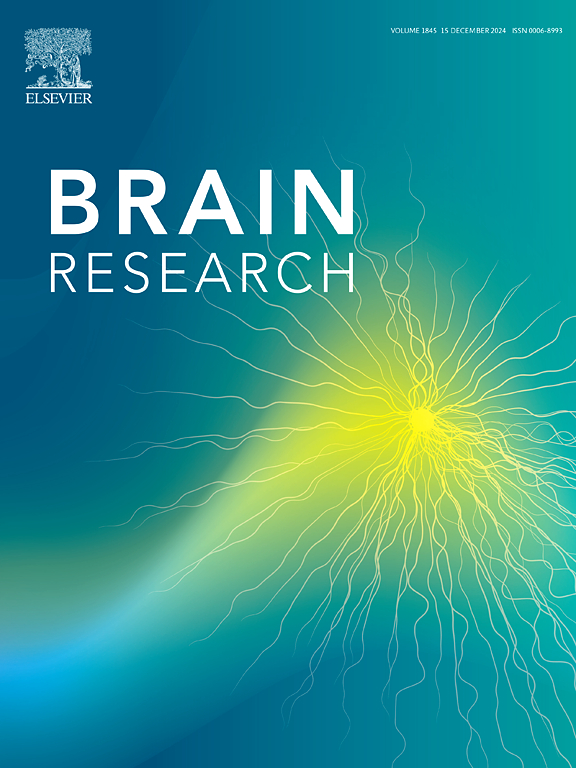Corydalis yanhusuo Polysaccharides regulates HPA-axis mediated microglia activation and inhibits astrocyte A1 transformation to improve depression-like behavior
IF 2.7
4区 医学
Q3 NEUROSCIENCES
引用次数: 0
Abstract
Depression is a common emotional disorder characterized by persistent low mood and decreased interest. Corydalis yanhusuo polysaccharides (CYP) are extracts from Corydalis yanhusuo, which have the effects of promoting blood circulation, relieving pain, anti-inflammation, and neuroprotection. This study investigates the effects and its underlying mechanisms of CYP in a chronic unpredictable mild stress (CUMS)-induced depression model using C57BL/6J mice. After 4 weeks of CYP treatment, the depressive behavior of mice was observed, and Nissl staining, H&E staining, and immunofluorescence were performed. The hypothalamic–pituitary–adrenal (HPA) axis factors levels were determined by enzyme-linked immunosorbent assay. Western blotting was used to detect protein expression. The results showed that CYP treatment improved depression-like behaviors in mice that received CUMS and ameliorated pathological damage the hippocampus and synaptic damage via regulating the expression of NeuN, SYP, and PSD95 proteins. CYP also reduced neuroinflammation by decreasing the expression of IL-1β, IL-18, NLRP3, and Caspase-1. In addition, CYP reduced adrenocorticotropic hormone (ACTH), corticotropin-releasing hormone (CRH), corticosterone (CORT), corticotropin releasing factor (CRF), mineralocorticoid receptor (MR) levels, and increased glucocorticoid receptor (GR) levels. Furthermore, CYP could regulate microglial activation and transform A1 astrocytes into neuroprotective A2 astrocytes, thereby mitigating neuronal damage by decreasing the expression of complement C3 (C3) and ionized calcium-binding adaptor molecule 1 (Iba-1), while increasing the expression of S100A10. However, CORT treatment significantly reversed above changes and aggravated depressive behavior in mice. In conclusion, CYP could improve CUMS-induced depression-like behaviors by regulating HPA axis-mediated microglial activation and inhibiting A1 transformation of astrocytes.

延胡索多糖调节hpa轴介导的小胶质细胞活化,抑制星形胶质细胞A1转化,改善抑郁样行为
抑郁症是一种常见的情绪障碍,其特征是持续的情绪低落和兴趣下降。延胡索多糖(CYP)是延胡索提取物,具有活血、止痛、抗炎、保护神经的作用。本研究以C57BL/6J小鼠为研究对象,探讨CYP在慢性不可预测轻度应激(CUMS)诱导的抑郁模型中的作用及其潜在机制。CYP治疗4周后,观察小鼠抑郁行为,并进行尼氏染色、H&;E染色和免疫荧光染色。采用酶联免疫吸附法测定下丘脑-垂体-肾上腺轴因子水平。Western blotting检测蛋白表达。结果表明,CYP治疗通过调节NeuN、SYP和PSD95蛋白的表达,改善了CUMS小鼠的抑郁样行为,改善了海马和突触的病理损伤。CYP还通过降低IL-1β、IL-18、NLRP3和Caspase-1的表达来减轻神经炎症。此外,CYP降低促肾上腺皮质激素(ACTH)、促肾上腺皮质激素释放激素(CRH)、皮质酮(CORT)、促肾上腺皮质激素释放因子(CRF)、矿物皮质激素受体(MR)水平,增加糖皮质激素受体(GR)水平。此外,CYP可以调节小胶质细胞的活化,将A1星形胶质细胞转化为具有神经保护作用的A2星形胶质细胞,从而通过降低补体C3 (C3)和离子钙结合适配器分子1 (Iba-1)的表达,增加S100A10的表达,从而减轻神经元损伤。然而,CORT治疗显著逆转了上述变化,并加重了小鼠的抑郁行为。综上所述,CYP可能通过调节HPA轴介导的小胶质细胞激活和抑制星形胶质细胞A1转化来改善cums诱导的抑郁样行为。
本文章由计算机程序翻译,如有差异,请以英文原文为准。
求助全文
约1分钟内获得全文
求助全文
来源期刊

Brain Research
医学-神经科学
CiteScore
5.90
自引率
3.40%
发文量
268
审稿时长
47 days
期刊介绍:
An international multidisciplinary journal devoted to fundamental research in the brain sciences.
Brain Research publishes papers reporting interdisciplinary investigations of nervous system structure and function that are of general interest to the international community of neuroscientists. As is evident from the journals name, its scope is broad, ranging from cellular and molecular studies through systems neuroscience, cognition and disease. Invited reviews are also published; suggestions for and inquiries about potential reviews are welcomed.
With the appearance of the final issue of the 2011 subscription, Vol. 67/1-2 (24 June 2011), Brain Research Reviews has ceased publication as a distinct journal separate from Brain Research. Review articles accepted for Brain Research are now published in that journal.
 求助内容:
求助内容: 应助结果提醒方式:
应助结果提醒方式:


